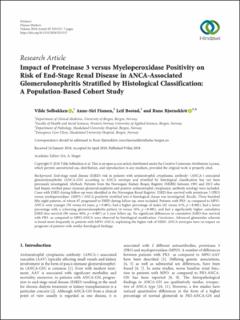| dc.contributor.author | Solbakken, Vilde | en_US |
| dc.contributor.author | Fismen, Anne-Siri | en_US |
| dc.contributor.author | Bostad, Leif | en_US |
| dc.contributor.author | Bjørneklett, Rune | en_US |
| dc.date.accessioned | 2019-02-08T17:22:28Z | |
| dc.date.available | 2019-02-08T17:22:28Z | |
| dc.date.issued | 2018-05-09 | |
| dc.Published | Solbakken V, Fismen AS, Bostad L, Bjørneklett RO. Impact of proteinase 3 versus myeloperoxidase positivity on risk of end-stage renal disease in ANCA-associated glomerulonephritis stratified by histological classification: A population-based cohort study. Disease Markers. 2018:2018:ID 3251517 | eng |
| dc.identifier.issn | 1875-8630 | |
| dc.identifier.issn | 0278-0240 | |
| dc.identifier.uri | https://hdl.handle.net/1956/19086 | |
| dc.description.abstract | Background: End-stage renal disease (ESRD) risk in patients with antineutrophil cytoplasmic antibody- (ANCA-) associated glomerulonephritis (ANCA-GN) according to ANCA serotype and stratified by histological classification has not been previously investigated. Methods: Patients from the Norwegian Kidney Biopsy Registry (NKBR) between 1991 and 2012 who had biopsy-verified pauci-immune glomerulonephritis and positive antineutrophil cytoplasmic antibody serology were included. Cases with ESRD during follow-up were identified in the Norwegian Renal Registry. ESRD-free survival with proteinase 3 (PR3) versus myeloperoxidase- (MPO-) ANCA positivity stratified into 4 histological classes was investigated. Results: Three hundred fifty-eight patients, of whom 87 progressed to ESRD during follow-up, were included. Patients with PR3- as compared to MPOANCA were younger (58 versus 64 years, p = 0 001), had a higher percentage of males (62 versus 41%, p < 0 001), had a lower percentage with a sclerozing glomerulonephritis pattern (4 versus 16%, p < 0 001), and had a significantly higher cumulative ESRD-free survival (90 versus 80%, p = 0 007) at 1-year follow-up. No significant differences in cumulative ESRD-free survival with PR3- as compared to MPO-ANCA were observed by histological stratification. Conclusion: Advanced glomerular sclerosis is found more frequently in patients with MPO-ANCA, explaining the higher risk of ESRD. ANCA serotypes have no impact on prognosis of patients with similar histological findings. | en_US |
| dc.language.iso | eng | eng |
| dc.publisher | Hindawi Publishing Corporation | eng |
| dc.rights | Attribution CC BY | eng |
| dc.rights.uri | http://creativecommons.org/licenses/by/4.0/ | eng |
| dc.title | Impact of proteinase 3 versus myeloperoxidase positivity on risk of end-stage renal disease in ANCA-associated glomerulonephritis stratified by histological classification: A population-based cohort study | en_US |
| dc.type | Peer reviewed | |
| dc.type | Journal article | |
| dc.date.updated | 2018-10-23T11:25:25Z | |
| dc.description.version | publishedVersion | en_US |
| dc.rights.holder | Copyright 2018 Vilde Solbakken et al. | |
| dc.identifier.doi | https://doi.org/10.1155/2018/3251517 | |
| dc.identifier.cristin | 1622213 | |
| dc.source.journal | Disease Markers | |

